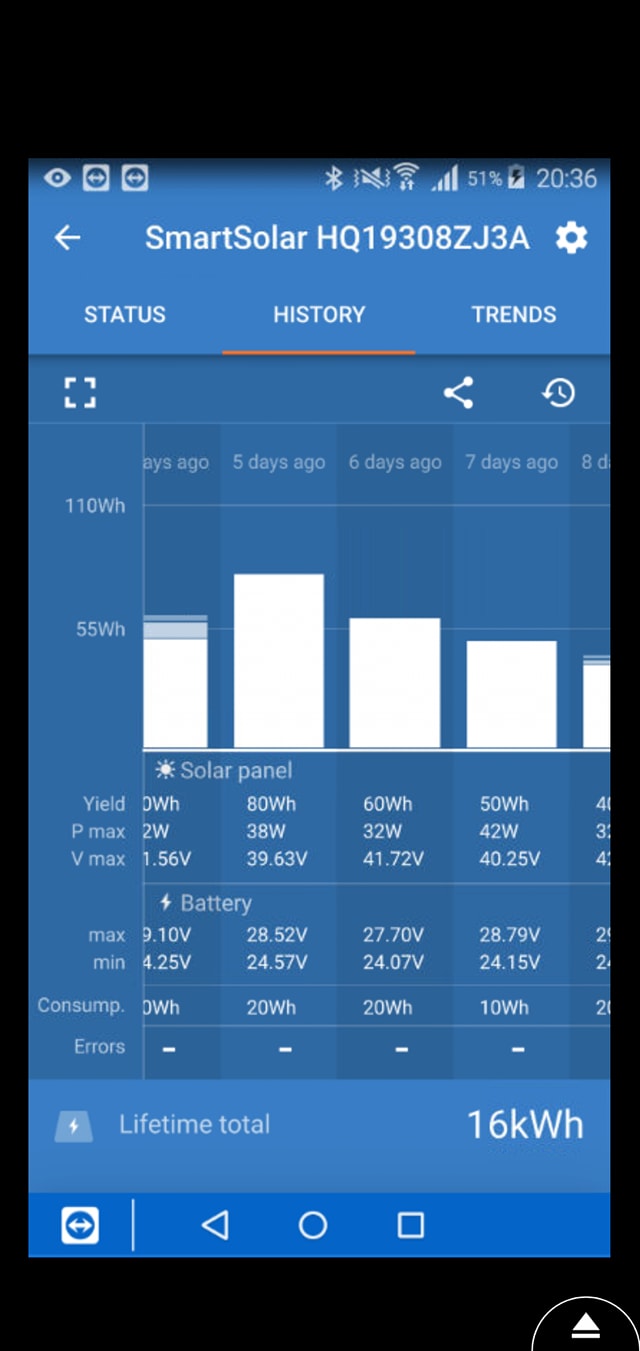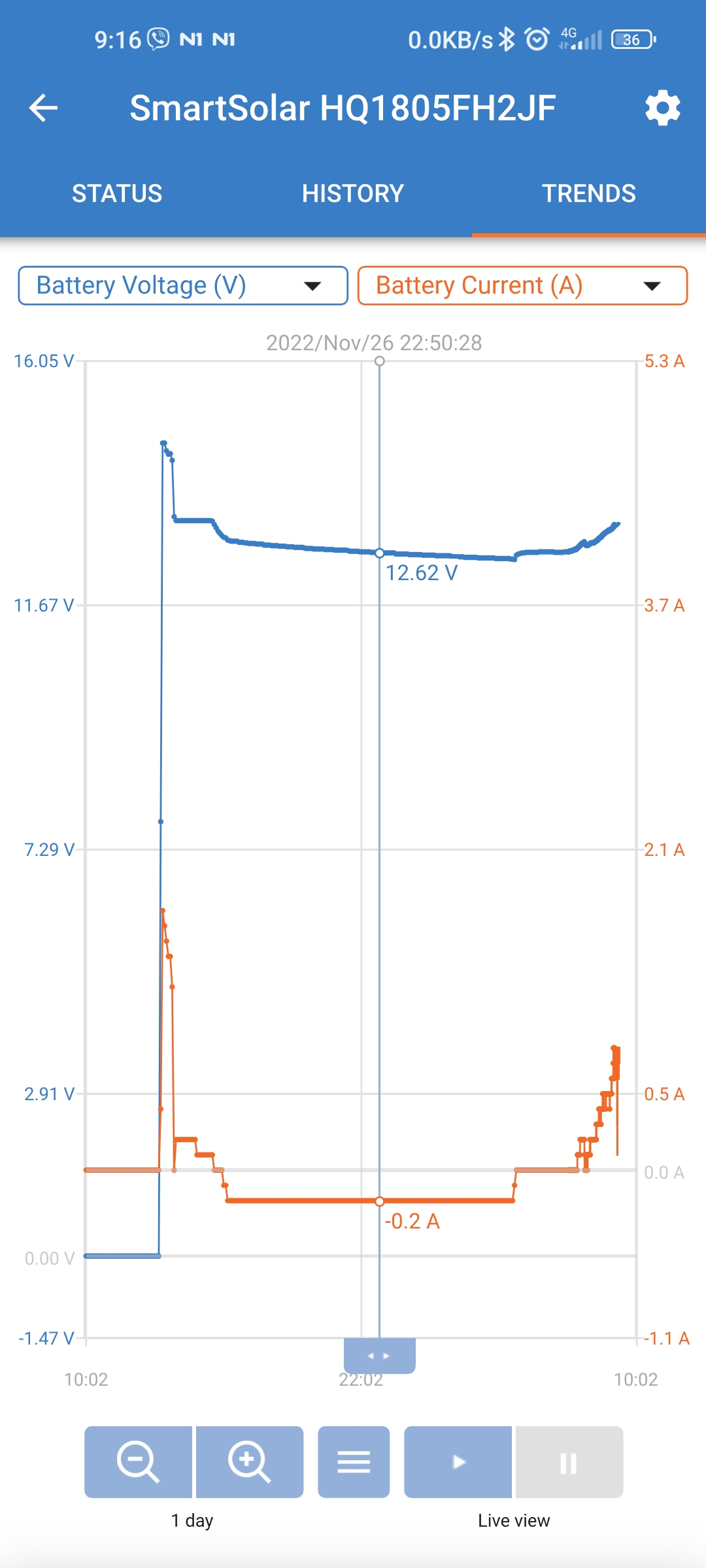 Hello guys,
Hello guys,
- Home
- Anonymous
- Sign in
- Create
- Spaces
- Grafana
- Node-Red
- Unsupported topics
- Questions & Answers
- Modifications
- Communauté francophone
- Deutschsprachiger Bereich
- Preguntas en Español
- Explore
- Topics
- Questions
- Ideas
- Articles
- Badges
question
Self-consumption Smart MPPT 75/15?
 Hello guys,
Hello guys,
Now after 4 days it has no juice to make the motor work, the voltage drops down to 23,8V :(
Hi ! Several things : in my opinion you are not providing enough energy to recharge the batteries. Depending of your region the degrees to use in your PV steup are not adapted to winter. Try adding another panel facing the sun during the afternoon, and also check what is the setup of your SmartSolar, if you have chosen the right charging mode for your batteries.
Michel.
Hi! Thanks for your reply. Of course I choose the setting for AGM battery in my app. As you see it's very small system, the motor needs 10-20Wh everyday when I have 2 x 25Ah Victron Deep cycle batteries (2 x 25 x 12 = 600Wh). In a good day the panels can go up to 55Wh/70Wh max, it's ok. Yeah I know in my region, specially in winter the sun light is rare, but I don't understand how 600Wh can be exhausted after 2, 3 days without sun light just because of the self-consumption. In the graph, the system could produce 190Wh and the consumption is just about 50Wh, the batteries didn't go to Absorpt or Float mode, so the self-consumption is > 140Wh in 3 days. I don't think the Victron AGM batteries discharge itself much like that.
 I noticed pretty much the same behavior on my off-grid system. I have 2x160W 12V PVs connected in series, 74Ah 12V battery and total daily consumption of the load is 100W. Battery should be able to deliver 12.5x74=925Wh. It means that load is barely above 10% of the max battery capacity. Beside that, load is powered directly from the PV for 5-6 hours per day, while during the rest of the day, power is provided by the battery bank.
I noticed pretty much the same behavior on my off-grid system. I have 2x160W 12V PVs connected in series, 74Ah 12V battery and total daily consumption of the load is 100W. Battery should be able to deliver 12.5x74=925Wh. It means that load is barely above 10% of the max battery capacity. Beside that, load is powered directly from the PV for 5-6 hours per day, while during the rest of the day, power is provided by the battery bank.
Battery if fully charged, but at the dawn, it went down to 50% which is almost 5x higher than total daily consumption.
How it can be possible?
Thanks
Is the load perhaps larger than you think?
What is the power rating of the motor and how many hours does it run? Did you check actual Amps used (e.g. using a clamp meter) to determine actual power used?
The screenshot shows the batteries don't get fully charged, at least on most days. Take day 6. Even with 60wh produced, the battery voltager does not go higher than 27.70. How much of the daily yeild is consumed directly by the load (i.e. unavailable to recharge the battery)? Perhaps install a cheap coulomb meter (e.g. https://hobbyking.com/en_us/turnigy-180a-watt-meter-and-power-analyzer.html) to see how much is actually going into, and out of the battery.
Also, don't forget that although battery voltage is a good indication of SOC, this is really only the case in a battery that has been resting (unconnected) for 24 hours. The voltage seen during charge will be higher than it actually is. I am not sure what the MPPT reports (V under charge or pseudo resting voltage). Unless the batteries have had an 8 hour soak at float, they will never be fully charged.
Another thing that may be worth mentioning is the 25Ah rating of the battery. If it is BAT412025081, it is the C20 rating. Unless your load is switched on 24/7, th2 C5 or C10 rating may be more appropriate.
More relevant I think is that the rating is given with discharge to 10.8V. You need discharge to 12V (in order to have the min. 24V for the motor to operate). I don't have a SOC graph at hand, but you will never get near 25Ah if your cutoff is 12V. Assuming linear voltage/soc relationship with 12.8V being 100% full and 10.8V being 100% depleted, you can only effectively use 0.8/2.0 = 40% of the battery capacity, i.e. 10Ah (C20).
Another important point is the effect of temperature on battery capacity.
Is your battery perhaps just too small for what you need?
Related Resources
question details
27 People are following this question.
